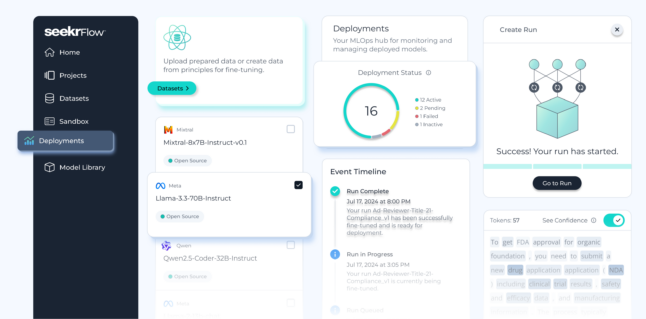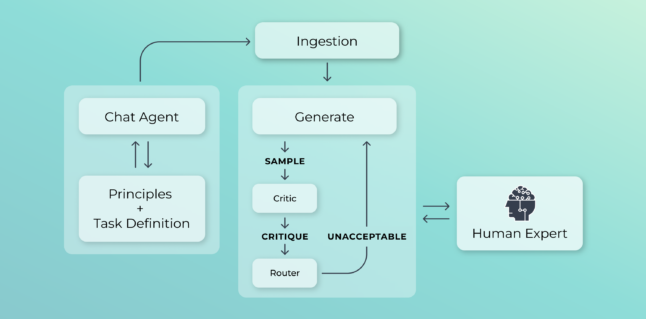Transparent AI for Enterprises: How to Open the Black Box to Build Trust and Realize AI Value
October 21, 2024
Key takeaways
- AI should never be opaque to users. Transparent AI helps enterprises understand AI model outputs so they can improve accuracy and build trust with customers and stakeholders.
- There is a pressing industry need to improve AI transparency—Stanford research shows that the average model transparency score among foundation model developers is just 58%.
- Developing transparent AI systems presents several challenges for teams due to the complexity of AI models, hurdles in data management, and a lack of explainability tools to understand model decisions.
- Using the latest techniques in explainability, contestability, and model retraining helps teams open the ‘black box’ of AI systems and foster transparency to realize AI value.
- Connect with our team of experts to learn how to build transparent AI solutions with the SeekrFlow™ AI platform.
What is transparent AI?
AI transparency is the ability to understand and explain why an AI system produces its outputs. Unlike black box AI systems that conceal the inner workings of a model, transparent AI allows users to validate the decision-making process and have confidence that the model will accomplish the goal.
Why transparency is critical in enterprise AI
Enterprises operate in industries governed by specific principles, regulations, and values—transparency helps them trust that AI models will adhere to these standards.
However, there is a pressing industry need to improve AI transparency—Stanford research shows that the average transparency score among foundation model developers is just 58%. Given the consequences that can occur from black box AI, enterprises should start every AI initiative with transparency top-of-mind.
Through transparent AI practices, companies can:
- Ensure equitable outcomes: Transparency enables businesses to identify and mitigate biases in AI models, leading to fairer outcomes.
- Reduce liability: Ensuring that AI-generated responses are accurate and explainable helps minimize legal risks.
- Foster trust with users: With transparent AI, companies can trace model decisions back to their data sources, ensuring accountability for the outcomes generated.
Transparency alone doesn’t eliminate biases and errors. However, it surfaces potential biases and enables teams to address these issues through bias detection and correction systems.
Use cases where AI transparency is key
Let’s take a look at some enterprise use cases where transparency makes or breaks the success of the AI application.
1. Customer service
In one type of customer service application, AI-powered chatbots interact with customers in place of humans. Without transparency, these chatbots could provide incorrect or inappropriate responses that can’t be explained, leading to customer dissatisfaction and potential legal liabilities. Transparent AI ensures that there is clear rationale for the answers given and customers can trust the responses they receive.
2. Recruitment
If AI is used to assess job applicants but lacks transparency, it may inadvertently introduce bias into hiring decisions that goes unnoticed. Transparency allows companies to understand why certain candidates are recommended, providing a fairer recruitment process.
3. Content creation
Enterprise employees use custom AI tools to generate content that is compliant with industry regulations. Transparent AI helps them understand the sources that influenced the AI’s output to validate that the content meets requirements.
Key components of transparent AI
Achieving AI transparency in enterprise environments requires a multi-step approach that involves:
1. Governance
AI governance encompasses the protocols and frameworks established to manage AI systems responsibly. This includes documenting all decisions made about the AI model, from initial design to iterative updates. Effective governance ensures compliance with internal policies and regulatory standards, creating a traceable record of AI development.
2. Explainability
If development teams can’t see why a model is producing outputs, they struggle to overcome errors. Explainability is about making the reasoning behind AI model decisions understandable to humans. This involves using techniques that allow users to see which data points influenced a model’s output so they can easily address biases and hallucinations and deploy more accurate models into production.
3. Communication
Effective communication about the AI system’s purpose, capabilities, and limitations is essential. Enterprises should be open with stakeholders about any biases identified and how these issues are being addressed. Transparency in communication fosters trust and encourages responsible AI usage.
Where enterprises struggle to achieve transparency
Because AI transparency is involved throughout the AI lifecycle, enterprises can face several challenges in their pursuit of building transparent AI systems, including:
- Complexity in model weights and biases: Despite well-understood architectures, deciphering how transformer models and LLMs represent knowledge within their complex network of weights and biases presents challenges, requiring explainable AI techniques to make their decision-making processes more interpretable.
- Data hurdles: Proper data documentation is a crucial step in achieving transparent AI—if you don’t understand your data, you can’t understand your model. The traditional data preparation process requires hundreds of hours, and sometimes hundreds of people, to sift through data scripts and ensure training data is well-structured, logical, and cleansed of errors and biases.
- Lack of tools and documentation: Few platforms offer built-in features to help developers implement explainable AI techniques. Validating a model before deployment can often become a long battle of trial and error.
Tools and techniques to enhance AI transparency
Enterprise teams can adopt several tools and techniques throughout development to produce transparent, trustworthy AI applications.
1. Improve data documentation
Transparent data documentation allows teams to trace the most influential portions of text that lead to specific model outputs.
With SeekrFlow Principle Alignment, teams can leverage an agentic data generation workflow to ingest, structure, and process the principles and guidelines they provide. Through recursive prompting, SeekrFlow distills the key facts, rules, tone, and style from the documents into a consistent, high-quality dataset that the user can review for accuracy before fine-tuning.
2. Utilize explainability tools
Users can leverage several explainability techniques to better understand the reasoning behind model outputs:
Influential sequences
When an LLM produces a response to a user prompt, influential sequences provide insight into which data points influenced the response, helping teams understand model decisions and identify specific areas in training data that need to be fixed.
Model comparisons
Side-by-side model comparisons enable teams to prompt and compare responses from two models simultaneously to choose the highest-performing model for their application.
Confidence scores
Confidence scores help users troubleshoot at the token level by having the model critique its own output. With the help of color-coded tokens, users can hover over individual tokens to examine scores and pinpoint where further validation might be needed.
3. Contest model outputs
Allowing stakeholders to challenge AI outputs promotes transparency. Contestability features enable users to identify errors in AI decisions and suggest corrections, which are then used to retrain the model to be more reliable.
4. Retrain models for domain expertise
Integrating human-in-the-loop feedback to improve model performance is another technique that promotes transparency in AI development. Users can contest incorrect AI outputs and use this feedback to retrain the model to better align it with domain-specific requirements.
For example, if a developer is building an AI-powered recruiter bot to assess job applicants for an organization, he can only train a model to the degree of expertise that he has. To achieve a higher degree of accuracy, development teams can incorporate human domain experts—in this case, experienced recruiters—in the retraining process, using reinforcement learning from human feedback (RLHF) to optimize model performance and align its behavior more closely to how a human expert would behave.
Conclusion: the success of enterprise AI hinges on transparency
Transparency opens the black box of AI and unlocks its value. Enterprises that prioritize AI transparency will be better equipped to reduce liability risks, comply with regulations, and build trust with users. To achieve the goal of their AI initiative, teams need to prioritize system governance, explainability, and contestability with the right tools and techniques.
Want to learn more about implementing transparent AI in your organization? Book a consultation with our team of experts to discuss your use case.



